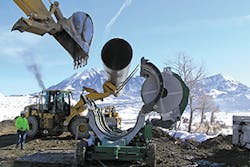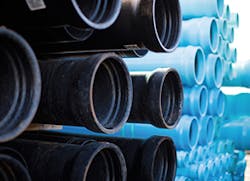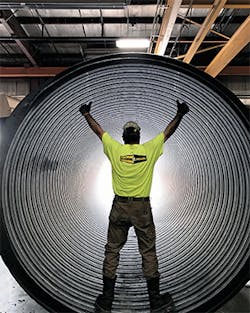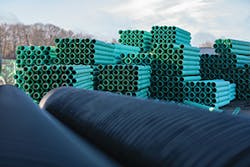Given the wide variety of pipe materials available, how do engineers and contractors select the right one for their diverse project applications? What are the best materials for different systems, for various soil types, and for different pressure levels?
The most common materials for the manufacture of water main pipes and fittings are metal (cast iron, ductile iron, steel, and copper), clay and concrete pipe (vitrified clay, reinforced concrete, and asbestos cement), and plastics (PVCs, HDPE, and fiberglass). The most common pipe diameter for water mains is 6 to 16 inches, with 8, 10, and 12 inches also being used. Branch lines providing service to individual homes, offices, buildings, and businesses vary in size from as small as half an inch in diameter up to 6 inches. Pipe wall thickness (a chief defining characteristic for determining a pipe’s structural strength and pressure rating) is measured differently by different types of materials, but is usually expressed as a ratio of the wall thickness to the pipe’s diameter. The question remains, what type of pipe material and size (or combination of several pipes in a distribution system) is best for which system? And what are those systems?
FORCE MAINS AND WATER SUPPLY PIPES
Waster distribution systems consist of either force mains or gravity sewers. The first rely on applied pressure heads induced by water pumps to generate flow in the pipes. The second rely on gravity (and the fact that the water runs downhill) to allow for water flows. Force mains tend to be smaller in diameter since the applied pressure can cause high-flow velocities even in small diameter pipes.
Water supply force mains usually get their applied pressure head directly from the elevation difference between the user and the community’s elevated water storage tank. Though this utilizes gravity feed, it is not an example of gravity flow since pumps were used to put the water into the elevated tank in the first place. The pressure is measured in feet of head by the elevation difference between the water level in the elevated storage tank and the spigot at the user’s household. With water’s density of 62.43 pcf, one foot of water head is equivalent to 0.43 psi. The available driving head is further reduced by in-line losses to friction (based on the roughness or smoothness of the pipe’s interior wall), flow velocity (based on the pipe’s interior diameter), and minor head losses imposed by fixtures and appurtenances (pipe bends, tees, valves, meters, flanges, etc.). The resultant head pressure within the pipe has to be contained by the pipe wall itself without rupturing or cracking and by all of the joints and fixtures connecting the pipe line segments.
Pipes can be damaged by other factors besides internal pressure. One such potential impact is water hammer. This is the shock that occurs when water flow under pressure is suddenly stopped by closing a valve, or when water flow abruptly changes direction as in a pipe bend. A strong enough water hammer can cause a pipe to break or even explode. Water hammer can be minimized by ensuring pipe flow velocities are less than 5 feet per second (fps) or by the installation of air traps, stand pipes, air release valves, vacuum relief valves, and water hammer arresters. The impact of water hammer at pipe bends can be minimized by reinforcing them with concrete thrust blocks or mechanical joint restraints (such as metal rings attached to the pipe and dead-bolted into an adjacent fixed structure). The dead weight of the blocks or tensile strength of the restraining rings will prevent the pipe bend from becoming dislocated or even broken.
The potential for pipe breakage in any pipeline is primarily a function of the material characteristics of the pipe materials and how they respond to applied internal and external forces. Certain pipe materials will be too brittle. Others will be chemically unsafe to use in water supply applications. Other pipe materials can only be effectively used as large diameter pipes.
GRAVITY FLOW SEWERS
Gravity sewers are the other primary use of pipelines in public spaces. Gravity sewers are networks of underground pipelines that carry stormwater to discharge at natural bodies of water and transmit sewage to a wastewater treatment facility (though both may use intermediate pump stations to overcome flat topography and loss of flow gradient). In both cases, flows are driven by gravity and elevational differences along the length of the pipes that have been installed with a sloping gradient. These pipe networks consist of many branch pipelines that feed into a central sewer main that carries the bulk of the accumulated flows to its final destination.
Sewers are sized and designed to carry flows in essentially an “open-channel” flow condition, at least until the depth of flow in the pipe increases to the pipe’s diameter. The diameter of the sewer pipe typically exceeds the diameter of a force main or a water supply pipeline carrying the same flows since the force mains have additional energy supplied by the applied pressure. However, sewers do need a minimum designed flow velocity to ensure that it remains self-cleaning and prevents the accumulation of sediment and debris that could clog the pipe (typically 2 to 2.5 fps).
Because of the need to maintain smooth flow grades even in variable terrain, the excavation depths needed to install a sewer pipe in its trench can be significant. Given the potentially large quantities of flow that sewers must carry, their diameters must be proportionally large. Having to install them in urban environments with their potential for traffic disruption and presence of existing buried utilities adds to the difficulty of building a sewer network. Together, these factors can add up to significant construction and installation costs. Their depth and size make them less susceptible to loads from vehicle impacts and vibrations. But they are more vulnerable to damage from earth movements which misalign the pipes, causing cracks and dislocated joints. And difficulty of access can make operations and maintenance more difficult.
METAL PIPES
Cast Iron Pipe was the original metal pipe used for most urban water main construction throughout the 20th century until the 1970s. Cast iron can still be found in the older sections of urban water distribution systems. It was relatively easy to manufacture and install. However, it is very brittle, making it prone to cracking and structural breakage. Since all urban water mains are subject to displacement from earth movements and impact loads from heavy truck traffic, the expected lifetime of a cast iron pipe is relatively short. Each applies a bending moment to the pipe length, which can cause it to crack and rupture. Additional damage occurs to cast iron water mains as a result of freezing temperatures and expanding ice within the water mains.
Ductile Iron Pipe was designed to replace cast iron pipe and has largely done so. Ductile iron pipe is more flexible, stronger, and less brittle than cast iron. Therefore, it can handle shocks from impacts and vibrations better and is less susceptible to failure from freezing conditions. However, both types of iron pipe are susceptible to corrosion over time which can weaken joint connections and effectively thin a pipe wall. To guard against corrosion, the interior walls of ductile iron pipe are often lined with a coating of applied cement mortar. This isolates the metal pipe walls from the water it is carrying. Its resistance to pressure and structural strength make it an ideal choice for water force mains.
Steel Pipe is more costly than ductile iron pipe; it is also inherently resistant to rust and corrosion and is lighter and stronger. Joints can be made by welding pipe ends together, ensuring overall pipeline strength. One problem it has is a susceptibility to temperature-induced strains. With a higher coefficient of thermal expansion, steel pipe increases more with hotter temperatures and contracts more with colder temperatures. Contractors and engineers have to take this into account when designing and installing a steel pipeline network to prevent potential buckling of the pipe lengths. However, its greater strength allows for the manufacture of larger diameter pipes capable of carrying greater flow rates.
Copper Pipe is used to make the final run from the water main to the households and businesses receiving the water. This use of copper continues on into the house with all of the household’s plumbing pipes and fixtures. Specifically, Type K copper piping is used for connection lines from the water main. This has a thicker pipe wall thickness and a higher pressure rating than other commercially available copper pipe (Type L and Type M). Copper is relatively soft, easy to manipulate, and forms into pipes and fixtures of variable sizes and shapes. This makes for ease of installation, simplicity of joint welding connection, and resistance to freezing. Copper lines can be thawed or prevented from freezing in the first place by the application of mild electrical current through the conductive copper pipe.
CLAY AND CONCRETE PIPES
Vitrified Clay, or ceramic pipes are the oldest kind of sewer and water supply pipelines in history, with the first such pipelines being installed in Mesopotamia 6,000 years ago. Since the beginning, clay pipes have been used for sewer and stormwater applications, and they remained the primary kind of sewer pipe until the early 20th century (though many of these vitrified clay pipe sewer systems are still functioning today). To ensure against crushing, fracturing, and leakage, clay pipes have tended to be designed and manufactured with thick pipe walls. This resulted in heavy weight per linear foot of pipe, requiring local manufacture to avoid the cost of transporting this heavy material. Later in the 19th century, rail made economic transport from central manufacturing plants feasible.
Manufacture of vitrified clay pipe requires casting the clay pipe segments in forms and molds, followed by air drying for 24 hours. The pipe material consists of simple clay, water, and a few organic additives, making vitrified clay pipe a very “green” building material. Once completely air dried, the pipe segments are fired in a kiln for at least 48 hours. The result is a material called terra cotta, which is stronger than traditional fired clays. Additional strength against applied pressure loads can be achieved by encasing it in concrete, therefore reinforcing the vitrified clay pipe. However, clay pipes are susceptible to damage from root intrusion and are clumsy to work with compared with lighter weight pipe materials such as PVC.
Core & Main offers innovative solutions for
new construction and aging infrastructure.
Reinforced Concrete Pipe is the commonly used cement-derived pipe material. However, reinforced concrete is difficult to mold into pipes with thin walls and/or small diameters. Concrete by itself is relatively strong in compression but weak in tension. So, an applied load to the pipeline can cause a bending moment of part or all of its length. The resultant “bending” of the pipeline, no matter how small, creates tension in the bottom portion of the pipe wall. This causes tension cracking unless reinforced with steel bars or mesh. These characteristics and its inherent strength in both compression and tension (due to its steel reinforcement) make it ideal for large diameter water transmission pipelines and gravity flow sewers and manholes. So reinforced concrete pipelines will be used in the main connectors and aqueducts connecting a water supply reservoir with the city utilizing the water. Reinforced concrete pipe can be as large as 20 feet in diameter.
Reinforced concrete pipe was first manufactured in the US in the early 20th century. There are five basic methods for manufacturing: wet castings, centrifugal/spinning, dry cast, packer head, and tamp-entail. Wet cast uses a concrete mix that is wetter than the other methods (concrete slump less than 4 inches). This method is typically used for the production of large diameter pipes and more complex fittings that require a highly flowable concrete mix to fill all the nooks and spaces in the casting mold. The need for the concrete to set reduces the number of pieces that can be produced by a single mold during the manufacturing process. The other methods utilize a drier concrete mix with zero slump and higher density. All of the dry cast methods utilize some sort of applied low-frequency and high-amplitude vibration to cast the high-density concrete into its proper shape. These dry processes allow the pouring of multiple pieces without deformation, increasing the productivity of one mold. The pieces slip out of the mold and resemble hard clay and dry within an hour.
Asbestos Cement Pipe differs from regular concrete in that it consists of a mixed aqueous slurry consisting of four-fifths Portland cement and one-fifth long- and medium-grade chrysotile asbestos fibers. The slurry is dewatered by a rotary sieves cylinder which also serves as the pipe mold. Once dried and removed from the rotary cylinder, the asbestos pipe is cured in a low-temperature oven. The asbestos fibers act as the reinforcing material, removing the need for more expensive steel reinforcement.
Asbestos cement pipe was popular due to its many physical advantages (lightweight, not subject to corrosion or rust, ease of manufacture, lower cost, etc.). However, exposure to asbestos by both workers at the manufacturing plant and end-users getting their water supply through these pipes has been deemed environmentally hazardous and too great a danger to human health. Asbestos cement pipe has not been manufactured in the US since the 1970s. Asbestos cement pipe is seldom used and typically removed.
PLASTIC PIPES
High-Density Polyethylene (HDPE) Pipe comes in two varieties: corrugated and solid-walled. Corrugated pipe can be joined into pipe lines by mechanically joining the ends of each pipe segment. Corrugated HDPE is normally used for storm drains and sanitary sewers. Solid-wall HDPE is joined together by butt-fusing the ends of the pipe segments together using applied heat and pressure. The result is an alignment welded joint that is actually stronger than the pipe itself. Fused HDPE is used for water lines and other force mains. In certain situations, such as pipelines carrying toxic chemicals or landfill leachate flowing outside a lined area of the landfill, the pipe is double walled with an interstitial space between the pipe walls. Conversely, fused HDPE can also be perforated or slotted so as to act as a collection drain pipe in French drains or in landfill leachate collection and extraction systems.
HDPE pipe is categorized by its SDR rating. “SDR” stands for “Standard Dimensional Ratio” and is equal to the normal outside diameter of the pipe and its pipe wall thickness. For example, an SDR-11 rated pipe would have an exterior diameter 11 times greater than its pipe wall thickness. With this rating system, pipes with lower SDR values would actually be stronger since their pipe wall thickness would be greater relative to its exterior diameter.
Typically installed in a trench, HDPE pipe strength against applied loads is considered to be partially a function of the surrounding backfill soil. As a non-rigid, non-pressurized pipe, the stability of the HDPE pipe should be considered as part of a soil/pipe system. Its potential for wall crushing, deflection, or other structural failure depends in large part on the backfill soil’s strength and measured by its soil modulus (calculated as the ratio of soil pressure to vertical soil strain at a specified in-place density). In addition to having to withstand static loads from backfill and overlaying pavement, HDPE pipes are designed to withstand applied impact loads. The standard impact load for design purposes is the H20 highway loading, which is based on a simulated 20-ton truck traffic and resultant impact. With a minimum 2 feet of cover, the H20 impact loading is equivalent to 900 pounds per square foot.
HDPE is manufactured from polyethylene resin using the extrusion technique. The PE resin and other admixtures are heated, mixed together, and extruded into the required shape, and made to hold that shape during the cooling process. The machine used to manufacture HDPE pipe is referred to as an extruder. Its job is to accept raw resin via a hopper feed, heat the resin with a thermocouple and heater band, mix the resin with a feeder screw, and push out the material through an appropriately sized die to create the pipe.
Polyvinyl Chloride (PVC) Pipe is widely used for new water main applications. PVC pipe material is inexpensive, durable, and lightweight. Furthermore, it is corrosion resistant and nonreactive with most chemicals. Only ductile iron pipe is used as often for water main applications. PVC pipe is manufactured in a process similar to that used to make HDPE pipe which requires an extruder machine. Instead of HDPE resin, the first stage in the production of PVC pipe is the combination of ethylene and chlorine to produce an intermediate product called ethylene dichloride. This becomes the chemical feedstock of the PVC powder that is fed into the extruder.
PVC is categorized by its Schedule (SCH) ratings, with SCH 40 and SCH 80 being the most commonly used. PVC Schedule is a measurement of the pipe wall thickness. A larger Schedule rating indicates a thicker pipe wall. Both SCH 40 and SCH 80 pipes have the same outside diameters. With differing pipe wall thicknesses, the SCH 80 would have the smaller interior pipe diameter because of its thick pipe wall. This results in different pressure ratings for each type of PVC pipe. For example, a 4-inch-diameter SCH 80 PVC pipe has a pressure rating of 320 psi, compared to a 4-inch diameter SCH 40 PVC pipe which has a pressure rating of only 220 psi.
As a more rigid pipe, the strength of a PVC pipe is a result of the pipe itself. Pipe bedding strength characteristics are also important, but the PVC pipe is not considered to be a pipe/soil structural system like HDPE, irrespective of surrounding soil or backfill. Applied loads for PVC pipes buried less than 50 feet deep are typically determined by the Modified Iowa Formula. This formula calculates potential horizontal pipe deflection as a function of applied vertical stress, pipe wall thickness and its moment of inertia, the pipe radius, PVC modulus of elasticity, and the bedding soil modulus. A projected maximum deflection of 7% is considered to provide a 4 to 1 factor of safety against pipe crushing.
Fiberglass Pipe (a.k.a. Fiberglass Reinforced Thermosetting Plastic or “FRP”) is used for water mains, force mains, and large-diameter gravity sewers. Like HDPE and PVC, fiberglass pipe is corrosion-resistant. A common construction material, fiberglass is used in a wide variety of applications including insulation and the manufacture of storage tanks. Unlike HDPE and PVC, FRP is manufactured not by extrusion but by a winding process that combines epoxy resins with self-reinforcing continuous glass filaments. The result is a material that is both inherently strong and resistant to chemicals and heat. It is popular in oil and gas production applications where it can resist extreme temperature and pressure regimes.
ratings, with SCH 40 and SCH 80 being the
most commonly used.
MAJOR SUPPLIERS
Krausz USA provides a variety of wide-range coupling solutions, including the Krausz HYMAX family. The HYMAX family of coupling solutions are engineered to enable fast stab-on installation and flexibility, as well as extreme durability in any working conditions, including maximum working temperature of 125°F. The HYMAX product line has been field-tested in over a million installations in North America. HYMAX couplings come in 1.5-inch to 60-inch pipe nominal size. Krausz can design custom-made products including extra-wide sizes, using diverse products and raw materials. HYMAX products in sizes 14 inches to 24 inches in all configurations are available with NBR gaskets in addition to EPDM. HYMAX MTO products (made to order) can be ordered with NBR gaskets in sizes of 26 inches to 60 inches. Replacement centering bolt kits are now available for HYMAX coupling sizes 14 inches and up.
Krausz HYMAX GRIP restraint products combine the patented technology of the HYMAX coupling with a unique restraint system, joining pipe ends while preventing any possible movement. Designed using Krausz’s patented technology, the HYMAX GRIP pipe restraints work with all metal and plastic pipes and are suitable for a wide variety of applications. HYMAX GRIP joins and restrains a wide selection of pipes of different types and diameters; it also allows the joining of pipes of same or different materials and diameters. HYMAX GRIP prevents axial pipe motion without the need for thrust blocks. The HYMAX GRIP’s patented gasket effectively transforms the pipe joint into a flexible connection and allows dynamic deflection of the pipe of up to 4 degrees per side, reducing future pipe cracks and breaks. The GRIP is made of highly durable ductile iron, and can withstand working temperature of up to 125°F or more.
US Pipe, a Forterra company, offers a complete range of ductile Iron pipe, restrained joint pipe, fabrication, gaskets, and fittings along with other products for the water and wastewater industries. US Pipe produces highly engineered pipe products for water and wastewater systems. For over 100 years, US Pipe has supplied the critical components to build durable water and sewer infrastructure. The company’s comprehensive selection of products allows US Pipe to offer customers the support needed to ensure a long-lasting waterworks system. US Pipe offers the added support of industry-specialized engineering teams to help design, build, and manage projects.
Based in St. Louis, Core & Main is the largest distributor of water, sewer, storm drain, and fire protection products in the US. Operating more than 250 branches nationwide, the company combines local expertise with a national supply chain to provide contractors and municipalities with innovative solutions for new construction and aging infrastructure. The company distributes products that are integral to building, repairing, and maintaining water and wastewater systems and which serve as part of the basic municipal infrastructure required to support population and economic growth, and residential and commercial construction. Their projects range from water and sewer line installation, stormwater retention systems, and water/wastewater treatment plant construction to fire protection equipment and services. Core & Main is one of the nation’s largest distributors of high-density polyethylene (HDPE) pipe for a broad range of applications, including municipal, industrial, landfill, geothermal, mining, and more. The company’s 3,000-plus associates are aligned to its vision: to foster a world where communities thrive because its people and products provide safe, sustainable infrastructure for generations to come.




